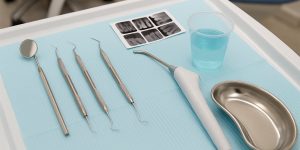Localized gum pain can range from mild irritation to sharp, persistent discomfort. Often, it indicates issues such as a gum abscess, gum ulceration, or infection in the surrounding tissues. Ignoring these symptoms may allow the problem to progress into more serious conditions like periodontal disease, which requires oral surgery.
In this article, we’ll explore common causes of one-spot gum pain, safe at-home measures, when to seek professional care, and preventive strategies. We’ll also show how professional care, including dental prophylaxis, periodontal therapy, and proper tooth cleaning, can restore and protect your gum health.

Common Causes of Localized Gum Pain
Localized gum pain may arise from several factors:
Gum Infection or Abscess
A periodontal abscess occurs when bacteria accumulate in the gums, resulting in swelling, pain, and sometimes the formation of pus. Food trapped along the gumline, untreated cavities, or early gum disease may trigger this infection. Persistent abscesses often require professional intervention, such as root canal therapy or tooth extraction.
Gingivitis or Early Gum Disease
Early-stage gingivitis can cause localized discomfort. Plaque buildup, inadequate oral hygiene, or irritation from certain foods are often contributing factors to tooth decay. Professional deep cleaning and daily oral care can help prevent the progression of dental issues.
Food Impaction
Food stuck between teeth can press against gums and cause sharp pain. Recurrent impaction may lead to infection or swelling. Maintaining proper oral hygiene and promptly removing trapped debris, as discussed in our article on signs of a cavity, can help prevent these problems.
Tooth Fracture or Cavity
Cracks or decay can irritate surrounding gum tissue, causing localized pain. Evaluation often involves X-rays to detect hidden fractures or decay.
Gum Ulcers
Minor trauma, irritation, or systemic conditions can lead to gum ulceration, resulting in localized pain. These usually heal within 1–2 weeks, but may worsen if poor oral hygiene or repeated irritation occurs.
Gum Recession
When gum tissue pulls back, the underlying tooth roots become exposed, leading to sharp localized pain and sensitivity. This condition may result from gum disease, overly aggressive brushing, or hereditary factors. Treatment often involves professional scaling, root planing, or corrective techniques to protect the exposed areas.
Irritation from Dental Restorations
Poorly fitted crowns, fillings, or dental bridges can irritate the surrounding gum tissue, causing persistent discomfort. Rough edges or improper placement may trap bacteria and worsen localized pain. A dentist can adjust or replace the restoration to restore comfort and protect gum health.

When to Try At-Home Care Safely
If the pain is mild and no swelling or pus is present, you can try these temporary measures:
- Warm Salt-Water Rinse: Helps reduce inflammation, clean the area, and alleviate pain. Proper rinsing also reduces the risk of food impaction, which is a common cause of localized gum pain.
- OTC Pain Relievers: Ibuprofen or acetaminophen can temporarily reduce swelling and discomfort.
- Gentle Oral Hygiene: Brushing carefully, flossing, and using antimicrobial mouthwash can prevent further irritation. Learning about different techniques to maintain gum health can be connected to the type of cosmetic dentistry procedure.
- Temporary Relief for Trauma: Pain from teeth grinding or irritation from a mouthguard can be minimized by using a properly fitted appliance.
These measures provide temporary relief but are not a substitute for professional evaluation, especially if the pain persists or worsens.
The Mayo Clinic medical team has also said this:
“Swollen gums can go away with proper treatment. In some cases, swelling can even get better on its own. For example, if you have a piece of food stuck in your gums, swelling should go away once you remove the food particle. But if gum disease causes swollen gums, you’ll probably need treatment. The sooner you treat gum disease, the better your chances for long-term oral health.”

When to See the Dentist
If your gums hurt in one spot and the discomfort persists, it’s important to seek professional dental care promptly. Pain that continues or intensifies can indicate underlying issues such as a gum abscess, tooth fracture, or early-stage gum disease. A dentist can accurately diagnose the cause, often using X-rays to reveal hidden problems, such as cavities or infections, that may not be visible to the naked eye.
Swelling, redness, or the presence of pus in the affected area are clear signs that professional intervention is required. These symptoms suggest that bacteria have accumulated, and the infection may be spreading to surrounding gum tissue, which could necessitate treatments such as periodontal therapy or tooth cleaning to remove plaque, tartar, and infected tissue effectively.
Persistent pain while chewing or sensitivity to hot or cold foods can also indicate that the pain is originating from the tooth rather than the gum alone. Conditions such as tooth fractures or deep cavities can cause pressure on the surrounding gum tissue, making professional evaluation essential to prevent further damage.
Seeking prompt dental care not only addresses the immediate discomfort but also prevents the progression of infection or damage that could lead to more invasive procedures, such as root canal therapy, tooth extraction, or advanced periodontal treatment. Early evaluation ensures that appropriate treatment is applied, minimizing the risk of complications and promoting faster, more effective healing.
Read more: The importance of regular oral checkups
Preventing Future Local Gum Pain
Taking proactive steps is the best way to protect your gums and prevent localized pain from developing. By understanding the common triggers, such as plaque buildup, food impaction, or teeth grinding, you can implement strategies that reduce inflammation and safeguard your oral health. The following preventive measures are effective ways to maintain healthy gums and avoid recurring discomfort.
- Maintain proper oral hygiene by brushing your teeth twice daily and flossing regularly.
- Schedule regular professional tooth cleaning (dental prophylaxis) appointments.
- Use a mouthguard if you grind your teeth or play contact sports.
- Avoid foods that frequently get trapped in the gumline.
- Monitor for early signs of gum infection or gingivitis and address them promptly.
By consistently following these preventive steps, you can significantly lower the risk of future localized gum pain. Protecting your gums not only prevents discomfort but also supports overall oral health, helping you maintain a strong, healthy, and pain-free smile for the long term.
Contact Leslie North Dental for a professional evaluation
Our team provides expert care, including periodontal therapy, tooth cleaning, and treatment for gum abscesses or ulcers, to relieve pain and protect your oral health.
Localized Gum Pain Shouldn’t Be Ignored
Even mild one-spot gum pain may signal issues such as a gum abscess, ulceration, or early gum disease. Ignoring these symptoms can lead to infection, tooth damage, or more invasive treatments. Proper evaluation ensures accurate diagnosis and effective treatment.
At Leslie North Dental, the best dental clinic in Newmarket, we offer safe and effective care for localized gum pain, including periodontal therapy, tooth cleaning, and evaluation for abscesses or tooth damage. You can rely on our experienced team to restore your oral health, prevent complications, and guide you in maintaining preventive care. Schedule an appointment today to effectively address localized gum discomfort.
FAQ
Can food stuck between teeth cause gum pain?
Yes, food trapped along the gumline can press against the gums, causing sharp, localized pain. Removing the debris and maintaining oral hygiene usually resolves the discomfort.
What’s a gum abscess vs. an ulcer?
A gum abscess is an infected pocket of pus, while a gum ulcer is an open sore caused by trauma or irritation. Both may cause localized pain, but abscesses require professional treatment.
How long will one-spot gum pain last?
Mild irritation may resolve within a few days, but persistent pain can indicate an infection or underlying damage. A professional evaluation is needed for an accurate diagnosis.
Can stress cause localized gum pain?
Stress can contribute indirectly by affecting oral hygiene or causing teeth grinding, which may irritate the gums.
Is self-medication safe for gum pain?
Temporary measures like salt-water rinses or OTC pain relievers can help, but they do not treat the underlying cause. Persistent or worsening pain requires professional care.
Have you experienced localized gum pain or have questions about its causes and treatment?
Share your thoughts below.
Our team at Leslie North Dental is here to provide expert guidance and care.





